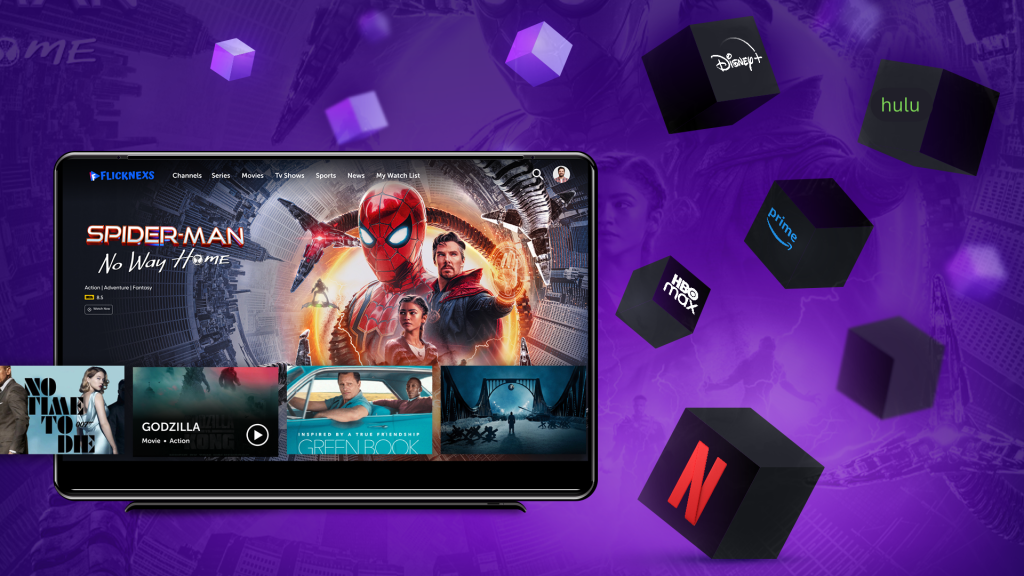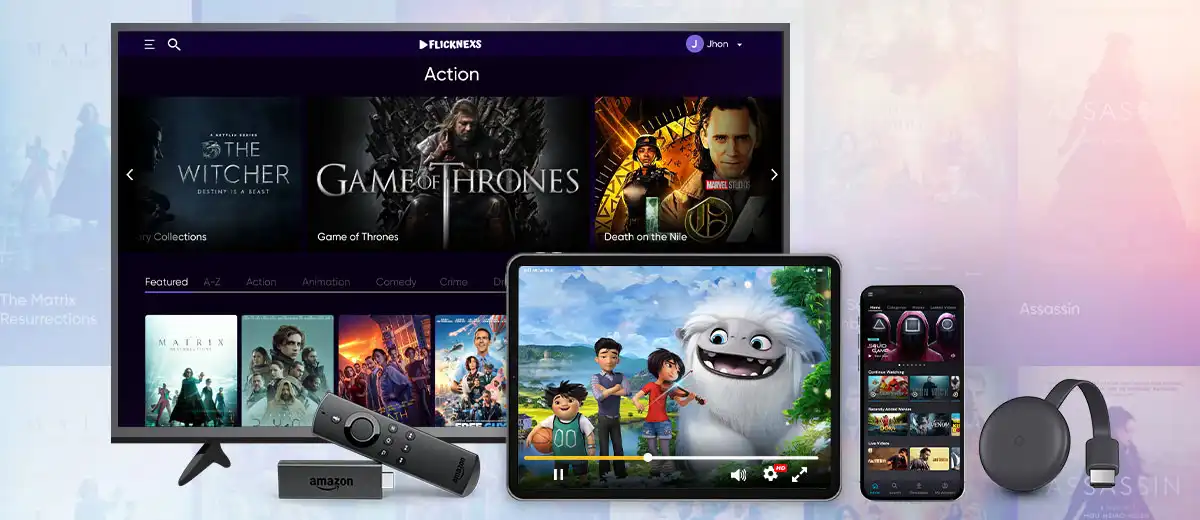In today’s digital age, traditional cable or satellite TV services are no longer the only way to access your favorite shows and movies. OTT TV Services have revolutionized the entertainment industry by offering on-demand streaming services over the internet.
According to recent statistics, the number of OTT TV subscribers in the US alone is expected to reach 227 million by 2025. This massive growth is largely attributed to the convenience and flexibility that OTT TV services offer, which allow users to watch their preferred content on multiple devices, at any time and anywhere they want.
But what exactly are OTT TV services and how do they work? Let’s take a look at a real-life scenario: imagine you’re on a business trip and want to catch up on your favorite TV show, but your hotel doesn’t have cable TV. With an OTT TV service, you can simply access the platform on your laptop or smartphone, and stream the show without any additional equipment.
In this article, we’ll explore everything you need to know about OTT TV services, including their benefits, types, popular platforms, and factors to consider when choosing a service. So, whether you’re a cord-cutter or just looking for a more flexible way to enjoy your favorite content, read on to learn more about OTT TV services and how they can enhance your entertainment experience.
What is OTT TV services?
OTT TV services refer to streaming platforms that allow users to watch TV shows and movies over the internet, without the need for a traditional cable or satellite TV subscription. These services offer on-demand access to a variety of content, which can be accessed through compatible devices such as smartphones, tablets, smart TVs, and laptops. OTT TV services are becoming increasingly popular due to their flexibility, convenience, and cost-effectiveness compared to traditional TV services.
How OTT TV Services Work
Accessing the Service:
The first step is to access the OTT TV service. This can be done through a smart device or a smart TV that has built-in streaming capabilities. Users can also use a streaming device like a Roku or Apple TV to access the service.
Choosing Content:
Once the user has access to the service, they can browse through the available content and choose what they want to watch. This can include movies, TV shows, documentaries, and more.
Requesting Content:
When the user selects content to watch, their device sends a request to the OTT TV service’s server to start streaming the content. The server then sends the content to the user’s device in small chunks, which are played back in real-time.
Content Delivery:
The OTT TV service uses a content delivery network (CDN) to ensure fast and reliable delivery of content. The CDN consists of a network of servers located around the world that work together to deliver content to users.
Playback:
Once the user’s device receives the content, it begins playing it back in real-time. The device buffers a small amount of content ahead of what is currently being played to ensure a smooth playback experience.
User Experience:
The user can interact with the content by pausing, rewinding, or fast-forwarding. Some OTT TV services also offer personalized recommendations based on the user’s viewing history and behavior.
Explanation of OTT technology
OTT technology, or over-the-top technology, is a method of delivering audio, video, and other media content over the internet, without the need for a traditional cable or satellite subscription. This technology allows viewers to access their favorite content on-demand, on their own schedule, from any device with an internet connection.
OTT technology has revolutionized the way people consume media content. Rather than being tied to traditional cable or satellite providers, viewers can now choose from a variety of OTT services, each offering its own library of content. This has given rise to new business models, such as subscription-based services and ad-supported models, and has disrupted the traditional advertising model.
Overall, OTT technology has changed the way we consume media content, giving viewers more control over their viewing experience and opening up new business opportunities in the television and entertainment industry.
Read More: OTT Content Providers: A Comprehensive Guide For Beginners
Comparison with traditional TV services
| Comparison between Traditional TV Services and OTT TV Services | Traditional TV Services | OTT TV Services |
| Delivery Method | Broadcast through cable or satellite | Delivered over the internet |
| Access | Requires a cable or satellite subscription and equipment | Can be accessed through internet-connected devices such as smartphones, tablets, and smart TVs |
| Content Library | Limited to channels provided by the cable or satellite provider | Vast libraries of on-demand content, including TV shows, movies, and original programming |
| Viewing Schedule | Viewers are tied to a specific programming schedule | Viewers can watch content on-demand and on their own schedule |
| Advertisements | Traditional commercial breaks | Ad-supported models or ad-free options available |
| Cost | Often expensive, with subscription and equipment fees | Variety of pricing options, including subscription-based models and pay-per-view options |
The table above provides a comparison between traditional TV services and OTT TV services. Traditional TV services rely on cable or satellite providers to broadcast content, while OTT TV services deliver content directly over the internet. Traditional TV services require a subscription and equipment, while OTT TV services can be accessed through internet-connected devices.
Benefits of OTT TV Services
OTT TV services offer a vast library of on-demand content, while traditional TV services are limited to the channels provided by the cable or satellite provider. Viewers of traditional TV services are tied to a specific programming schedule, while viewers of OTT TV services can watch content on-demand and on their own schedule.
Advertisements on traditional TV services are delivered through traditional commercial breaks, while OTT TV services offer a variety of options, including ad-supported models and ad-free options. Finally, traditional TV services are often expensive, with subscription and equipment fees, while OTT TV services offer a variety of pricing options, including subscription-based models and pay-per-view options.
Popular OTT TV Services

Netflix
Netflix is a popular OTT TV service that offers a wide range of TV shows, movies, and original programming. Some of the pros of Netflix include its extensive library of content, user-friendly interface, and ability to download content for offline viewing.
The pricing for Netflix starts at $8.99 per month for the Basic plan, $13.99 per month for the Standard plan, and $17.99 per month for the Premium plan.
Hulu
Hulu is another popular OTT TV service that offers a mix of live TV and on-demand content. Some of the pros of Hulu include its affordable pricing, access to current TV shows, and ability to create multiple profiles for different users.
The pricing for Hulu starts at $5.99 per month for the Basic plan, $11.99 per month for the No Ads plan, and $64.99 per month for the Live TV plan.
Amazon Prime Video
Amazon Prime Video is a streaming service that is included with an Amazon Prime subscription. Some of the pros of Amazon Prime Video include its extensive library of content, ability to rent or buy movies and TV shows, and access to Amazon Originals.
The pricing for Amazon Prime is $12.99 per month or $119 per year.
Disney+
Disney+ is a streaming service that offers a variety of content from Disney, Pixar, Marvel, Star Wars, and National Geographic. Some of the pros of Disney+ include its affordable pricing, family-friendly content, and ability to download content for offline viewing.
The pricing for Disney+ is $7.99 per month or $79.99 per year.
HBO Max
HBO Max is a streaming service that offers a wide variety of content from HBO, as well as a selection of movies and TV shows from other networks. Some of the pros of HBO Max include its extensive library of content, ability to watch new releases, and ad-free viewing.
The pricing for HBO Max is $14.99 per month.
These popular OTT TV services offer a range of pricing options and features to meet the needs of different viewers. It’s important to research and compare before subscribing to ensure you get the best value for your money.
Comparison of features and pricing
| Service | Monthly Price | Free Trial | Number of Streams | Video Quality | Offline Viewing | Original Content | Live TV | Ad-Supported |
| Netflix | $8.99 – $17.99 | 30 days | 1 – 4 | HD/4K | Yes | Yes | No | No |
| Hulu | $5.99 – $64.99 | 30 days | 2 – Unlimited | HD | Yes | Yes | Yes | Yes |
| Amazon Prime Video | Included with Amazon Prime ($12.99/month or $119/year) | 30 days | 3 | HD/4K | Yes | Yes | No | Yes |
| Disney+ | $7.99 – $79.99 | 7 days | 4 | HD/4K | Yes | Yes | No | No |
| HBO Max | $14.99 | 7 days | 3 | HD/4K | Yes | Yes | Yes | No |
The table presented showcases some of the key features and pricing for these popular OTT TV services. Notably, each service offers different options for streaming, with varying numbers of simultaneous streams and video quality options. Moreover, some services also provide original content, live TV options, and offline viewing. Therefore, it is essential to compare these features and pricing to determine which service is the best fit for your needs and budget.
Explore More: 5 Simple Steps to Create Your Own OTT Platform
Pros and Cons of OTT TV Services
Pros:
Convenience:
One of the biggest advantages of OTT TV services is the convenience they offer. With these services, viewers can watch their favorite shows and movies anytime and anywhere they want, as long as they have an internet connection. This allows viewers to watch content on their own schedule, without having to worry about missing their favorite shows.
Cost:
OTT TV services are generally less expensive than traditional cable TV services. Viewers can subscribe to only the channels they want to watch, rather than paying for a whole package of channels they don’t need. Additionally, many OTT TV services offer free trials, allowing viewers to test the service before committing to a subscription.
Variety:
There are many different OTT TV services available, each with its own unique selection of content. This allows viewers to choose from a wide variety of shows, movies, and other content, rather than being limited to the offerings of a single cable TV provider.
Cons:
Internet Connection:
A reliable and fast internet connection is essential for optimal performance of OTT TV services. Slow or unstable connections may result in interruptions such as buffering, which can hinder viewers’ experience.
Content Availability:
While OTT TV services offer a wide variety of content, there may be some shows or movies that are not available on these services. For example, some content may be exclusive to certain cable TV providers or streaming services.
Subscription Costs:
While OTT TV services can be less expensive than traditional cable TV services, the costs can add up if viewers subscribe to multiple services. Viewers may need to prioritize which services they want to subscribe to based on their budget and the content they want to watch.
How to Choose an OTT TV Service
Choosing an OTT TV service can be overwhelming, especially with so many options available in the market. Here are some factors to consider when selecting an OTT TV service:
Determine your content preferences and needs.
- Identify the type of content you want to watch, such as TV shows, movies, or live sports.
- Consider the number of users and devices that will be using the service.
Compare pricing and subscription plans.
- Check if the service offers a free trial period to test the service before committing.
- Compare subscription plans and pricing to determine which one fits your budget.
Check device compatibility.
- Ensure that the service is compatible with the devices you plan to use.
- Check if the service offers apps for the devices you plan to use.
Evaluate user interface and user experience.
- Check if the service has a user-friendly interface and easy navigation.
- Consider personalized recommendations based on your viewing history.
Check the quality of streaming.
- Check if the service offers high-definition or ultra-high-definition streaming options.
- Ensure that your internet connection can support the streaming quality.
Evaluate customer support.
- Check if the service provides multiple ways to contact customer support, such as email, phone, or live chat.
- Evaluate customer reviews to see how responsive and helpful the customer support team is.
By considering these factors, you can select an OTT TV service that best fits your preferences and budget.
Conclusion
OTT TV services have revolutionized the way we consume television content. They offer a more flexible and personalized viewing experience, with a wide range of content options and affordable pricing plans. With the increasing popularity of OTT TV services, it’s important to understand how they work, their features, and how to choose the best one for your needs.
As Jeff Bezos, the founder of Amazon, once said, “If you make customers unhappy in the physical world, they might each tell six friends. If you make customers unhappy on the Internet, they can each tell 6,000 friends.”
Therefore, it’s crucial to choose a reliable and customer-centric OTT TV service that meets your expectations and provides an exceptional viewing experience.
As Mark Cuban aptly put it, “Every business needs to constantly adapt and evolve.” This rings particularly true for the OTT TV industry, which, with the continuous advancements in technology and changing consumer preferences, will have to adapt and innovate to stay ahead in the game.
So, stay informed and choose the best OTT TV service that fits your preferences and budget. Happy viewing!
Frequently Asked Questions
1. What is an OTT TV service?
Examples of popular OTT TV services, such as Netflix, Hulu, Amazon Prime Video, and Disney+, refer to streaming services that deliver video content over the internet, bypassing traditional cable or satellite television providers.
2. How does an OTT TV service work?
OTT TV services work by transmitting video content through an internet connection directly to the user’s device, such as a smart TV, computer, tablet, or smartphone. Users can access the service by signing up and paying a subscription fee, which often grants them access to a library of movies, TV shows, and original programming.
3. Is it possible to download content for offline viewing on an OTT TV service?
Many OTT TV services allow users to download content for offline viewing. This is particularly useful for users who want to watch shows or movies on the go or in areas with poor internet connectivity. However, not all services offer this feature, and the availability of offline content may vary depending on the platform and licensing agreements with content providers.
4. Are all OTT TV services available worldwide?
Most major OTT TV services are available in multiple countries, but not necessarily worldwide. Some services may have restrictions on the availability of certain content in certain regions due to licensing agreements or censorship laws. Additionally, some services may not be available in certain countries due to local regulations or the service’s own business decisions.



Leave a Reply